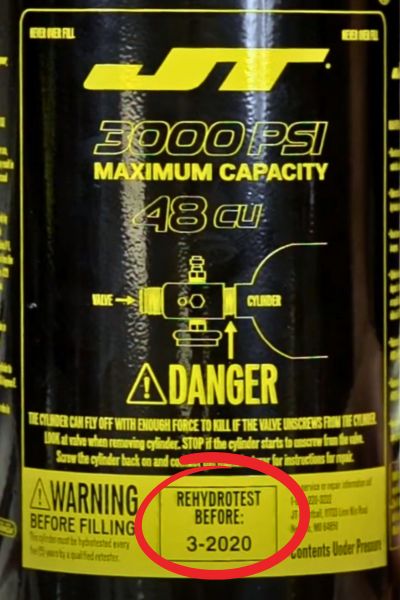Years ago, when my buddy Kieren told me that his paintball tank was losing pressure gradually even when it wasn’t in use, I asked, “Is this the new cylinder you bought last month?”.
To my surprise, he clarified that it wasn’t; that particular tank was reserved exclusively for tournaments. But, this old cylinder already weathered more than three years of use.
My next question caught him off guard. “When was the last time you got it HYDRO-TESTED?” I inquired.
Perplexed, he responded, “What do you mean?” Sensing his confusion, I explained that it’s a legal requirement to hydro-test paintball tanks regularly. As a result, he got it examined immediately, and guess what? It was leaking and no longer serviceable.
What Is Hydrostatic Testing For Paintball Tanks?
Hydro-testing or hydrostatic testing is a pressure testing procedure that evaluates the INTEGRITY of the tank and identifies CRACKS and LEAKS. The Pipeline and Hazardous Material Safety Administration (PHMSA) in the Department of Transportation (DoT) mandates examining paintball tanks every 3-5 years during their 15-year service life.
For example, paintball tanks with a DOT 3HT rating require a test every 3 years, while DOT 3A, ICC 3A, or DOT 3AL cylinders should be assessed once every 5 years.
Since we were already at an arena that offered hydrostatic testing, Kieren was able to get it done right away. Let me give you a quick rundown of the process:
Step 1: Visual Inspection
The cylinder first underwent a visual testing phase to detect any noticeable cracks on the surface. Although there was indeed a crack, we initially overlooked it because it was TOO THIN and located along a bend. Phil, the expert inspecting Kieren’s tank, also used a light to inspect for signs of corrosion, but he didn’t find any.
Step 2: Leak Detection
Now comes the interesting part – he attached a hose to the paintball tank’s nozzle and started filling it with pressurized water. Soon, a bright orange streak appeared near the seams, and an orange liquid started to trickle out. This is when Phil told us the water is dyed to make leaks easier to detect.
Step 3: Elasticity Testing
Though we had already discovered the leak, Phil agreed to go ahead with the rest of the testing to show us how it was done. He put the tank in a steel water jacket and continued filling it up to its MAXIMUM PRESSURE CAPACITY, i.e., 3,000 PSI.
He explained that The trick lies in checking the volume of water the cylinder displaces as it expands. Every paintball tank comes with a Rejection Elastic Expansion (REE) Rating – which was 13.5 cubic centimeters for Kieren’s. If water displacement exceeds the REE rating or the pressure vessel seems to have expanded permanently, it’s no longer safe to use.
Most paintball tanks are labeled with the due date of REHYDROTEST, allowing you to easily track their status. Here is a photo of the label on Kieren’s old cylinder, including all the necessary details.

Maximum Pressure Capacity (PSI) Of Paintball Cylinders
The pressure rating of a paintball tank can vary quite a bit, but it typically ranges from 3000 PSI to 5000 PSI. Carbon fiber tanks are usually on the higher end of the spectrum compared to aluminum tanks because they are made of a more robust material and can hold more gas. During a hydrostatic test, the cylinders are pressurized to their respective PSI capacity, reaching their maximum limits.
Is It Worth Hydro-testing Your Tank?
There’s a reason why testing your paintball tank is required by Federal Regulations– old cylinders with weakened bodies are dangerous to use. I’m sure you wouldn’t want a compressed CO2/HPA-filled cylinder exploding so close to your body.
However, whether it’s worth your money is another matter altogether. It cost Kieren $30 to get his tank tested at the arena. Considering that it would only cost him around $50 to get a new 3000 PSI cylinder, this would definitely be the MORE ECONOMICAL option. Yet, with the best quality paintball tanks, you will have another three years until the due date. How thought-provoking is that?
Nevertheless, some places charge more for hydrostatic tests, and you may have to shell out around $45 to $50 – especially if the tank needs to be shipped. If you can’t find cheaper options, examining your paintball tank might not be worth it; you’d be better off getting a new tank.
How Often Do CO2 Tanks Need To Be Hydro-tested?
All aluminum CO2 tanks have to be tested once every 3 to 5 years, and the same goes for most carbon fiber or fiberglass manufactured during the last decade. In the past, carbon fiber cylinders had to be checked every three years.
However, most of these cylinders are now outdated or nearly past their lifespan. Assessing your CO2 paintball tank every five years is fine, as long as it meets the guidelines set by the PHMSA.
Is The Testing Frequency The Same For HPA Tanks?
HPA paintball tanks must be checked at the same frequency as CO2 ones, i.e., once every 3-5 years, depending on their specifications. The only exception would be carbon fiber or fiberglass HPA manufactured more than 10-12 years ago; those might need to be tested more frequently.
Costs Involved To Hydro-test A Paintball Tank
The cost of hydro-testing your tank varies, but it usually ranges between $30 and $55. Visit or contact your nearby venues to check how much they charge.
Some companies, like Paintball Hydro, might also sell hydro-testing packs. Priced at $54.99, the pack includes a thread cap, packing materials, a box to put your tank in, a prepaid label for shipping the box to the company, the cost for shipping it back to you, and, of course, you will get the results and certificates.
Where Can You Test Your Tank?
There are dedicated hydro-testing service providers that could help you out with this. Paintball Hydro is one of them, as I mentioned earlier. Manufacturers of paintball accessories and supplies, like Ninja Paintball, for example, offer this service too.
Personally, I prefer getting my tanks examined at nearby facilities since it’s usually the most convenient and cheapest option.
You can watch this video of hydro-testing paintball tanks and its fundamentals:
Can You Reuse A Tank That Failed In The Test?
Unfortunately, a tank that fails the hydro test CAN’T BE REUSED. Once its body is too weak to sustain the air pressure and starts expanding more than it’s supposed to, there isn’t much you can do. Similarly, it would have been unsafe to patch up the crack and continue using the cylinder.
Tanks that fail the test don’t really serve a purpose anymore – you’d have to discard them. I usually sell my old equipment as scrap, but you can also dispose of them at recycling centers.
Tips To Keep A Paintball Tank In Top-notch Condition
While aluminum potentially lasts longer, and even the 15-year lifespan of carbon fiber seems more than enough, you still need to take proper care of your paintball tank.
Here’s the thing – they are still prone to wear and tear as they’re used repeatedly, which is why they need hydro-testing in the first place. Here are some tips to keep your paintball cylinder in top-notch condition and ensure it passes the tests.
Keep the tank clean and dry – you don’t want it to start getting corroded. As mentioned earlier, corrosion is among the first things they check during hydrostatic tests.
Take some time to oil the O-rings regularly to keep them in good condition and prevent wear. However, only use oils specifically meant for paintball marker guns – other types would be less effective.
When oiling the O-rings, make sure not to let any oil get inside the tank. This is more of a safety tip than a maintenance one, but it’s super important. Oil can combust at high pressures, so your cylinder can explode if you fill it to 3000 PSI and above with some oil left in it.
Clean your paintball tank regularly during routine maintenance. Dirt and grime building up inside the vessel can wear down its condition too.
When the tank isn’t in use, put on a thread protector and a fill nipple cover. While the former will protect the thread against corrosion and damage, the latter will protect the fill nozzle and prevent dirt and dust particles from entering the interior.
Ensure you get your paintball tank retested every 3 or 5 years, as required. You should also inspect for visual signs of damage every once in a while.
Securing Your Paintball Tank: Closing Advice
So, my friends, I hope I’ve answered your questions about hydro-testing your paintball tank. I’ve covered pretty much everything you need to know about the procedure and related information, so I hope you won’t have any issues. No worries, it’s easy peasy!
Just take your paintball tank to the nearest venue with a testing facility, and they’ll have you covered. Most importantly, don’t skip the hydro tests; playing with an unexamined cylinder for longer than 5 years can be quite dangerous.

